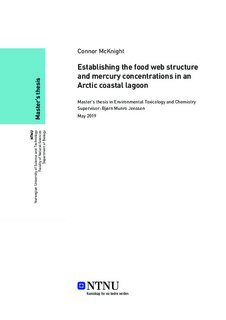| dc.description.abstract | Arctic coastal lagoons are dynamic ecosystems which make up large portions of the Arctic coastline. Despite this, lagoon ecosystems have seldom been studied in the Arctic, therefore there is limited knowledge on food web structures and contaminant concentrations in these ecosystems.
Mercury (Hg) is a non-essential, toxic heavy metal which has previously been shown to accumulate in Arctic environments at enhanced concentrations that can induce toxic effects in high trophic level species. Due to lagoons being heavily influenced by the surrounding terrestrial environment, lagoons may be potential hotspots for Hg accumulation as climate change is leading to increased melting and transportation of terrestrially derived organic matter and associated contaminants such as Hg. We therefore developed this study with the intent to provide baseline information on a coastal lagoon on Svalbard (Richardlaguna) including data on food web structure and concentrations of total mercury (TotHg) and methylmercury (MeHg) in water, sediments and biotic samples.
The lagoon food web (based on available samples) was comprised of brown macroalgae, littoral amphipods, polychaetes, bivalves, gastropods, holothurians, priapulids, shorthorn sculpin (Myoxocephalus scorpius) and Arctic staghorn sculpin (Gymnocanthus tricuspis). Stable isotopes of carbon (δ13C) revealed that lagoon fauna generally relied on marine carbon sources compared to terrestrial carbon sources. Values of stable nitrogen isotopes (δ15N) were used to approximate the trophic level of lagoon fauna, which revealed a trophic range of 1-4.2 (brown macroalgae-shorthorn sculpin).
Lagoon stream inlets had the higher concentrations of aqueous and particulate Hg than the lagoon and the outer marine environment, which highlights the importance of terrestrial inputs as sources of Hg to lagoon ecosystems. Concentrations of TotHg differed significantly between particulate organic matter and sculpin (p=0.0001), as well as macroalgae and sculpin (p=0.003), with a range of 0.68-418 ng/ g dw. Based on these data, we calculated a trophic magnification slope of 0.18 and a trophic magnification factor of 3.4, which indicated that TotHg is biomagnifying through the lagoon ecosystem.
These findings highlight the importance of Arctic coastal lagoon ecosystems as potential hotspots for inputs of terrestrially derived organic matter and Hg. To the authors knowledge, this is the first study to report stable isotope data and environmental concentrations of Hg in a lagoon ecosystem from Svalbard. | |
